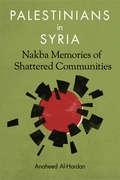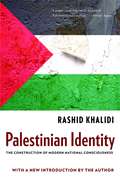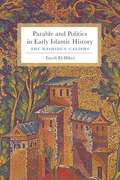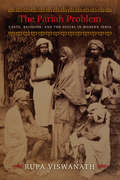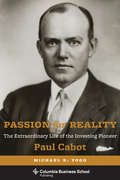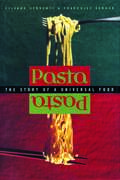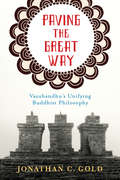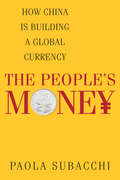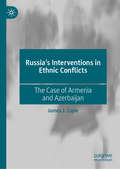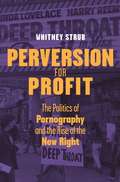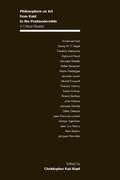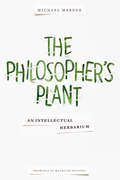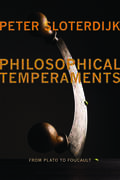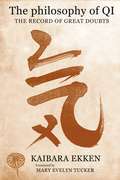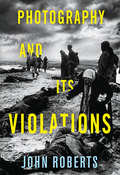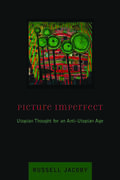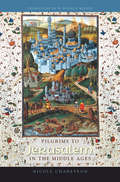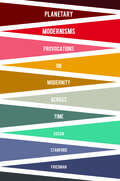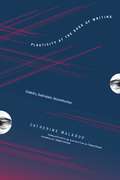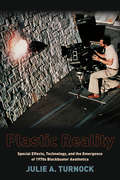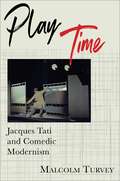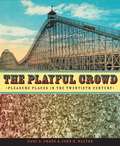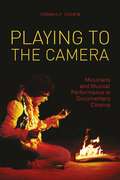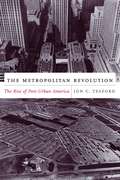- Table View
- List View
Palestinians in Syria: Nakba Memories of Shattered Communities
by Anaheed Al-HardanOne hundred thousand Palestinians fled to Syria after being expelled from Palestine upon the establishment of the state of Israel in 1948. Integrating into Syrian society over time, their experience stands in stark contrast to the plight of Palestinian refugees in other Arab countries, leading to different ways through which to understand the 1948 Nakba, or catastrophe, in their popular memory. Conducting interviews with first-, second-, and third-generation members of Syria's Palestinian community, Anaheed Al-Hardan follows the evolution of the Nakba—the central signifier of the Palestinian refugee past and present—in Arab intellectual discourses, Syria's Palestinian politics, and the community's memorialization. Al-Hardan's sophisticated research sheds light on the enduring relevance of the Nakba among the communities it helped create, while challenging the nationalist and patriotic idea that memories of the Nakba are static and universally shared among Palestinians. Her study also critically tracks the Nakba's changing meaning in light of Syria's twenty-first-century civil war.
Palestinian Identity: The Construction of Modern National Consciousness
by Rashid KhalidiThis foundational text now features a new introduction by Rashid Khalidi reflecting on the significance of his work over the past decade and its relationship to the struggle for Palestinian nationhood. Khalidi also casts an eye to the future, noting the strength of Palestinian identity and social solidarity yet wondering whether current trends will lead to Palestinian statehood and independence.
Parable and Politics in Early Islamic History: The Rashidun Caliphs
by Tayeb El-HibriThe story of the succession to the Prophet Muhammad and the rise of the Rashidun Caliphate (632-661) is familiar to historians from the political histories of medieval Islam, which treat it as a factual account. The story also informs the competing perspectives of Sunni and Shi'i Islam, which read into it the legitimacy of their claims. Yet while descriptive and varied, these approaches have long excluded a third reading, which views the conflict over the succession to the Prophet as a parable. From this vantage point, the motives, sayings, and actions of the protagonists reveal profound links to previous texts, not to mention a surprising irony regarding political and religious issues.In a controversial break from previous historiography, Tayeb El-Hibri privileges the literary and artistic triumphs of the medieval Islamic chronicles and maps the origins of Islamic political and religious orthodoxy. Considering the patterns and themes of these unified narratives, including the problem of measuring personal qualification according to religious merit, nobility, and skills in government, El-Hibri offers an insightful critique of both early and contemporary Islam and the concerns of legitimacy shadowing various rulers. In building an argument for reading the texts as parabolic commentary, he also highlights the Islamic reinterpretation of biblical traditions, both by Qur'anic exegesis and historical composition.
The Pariah Problem: Caste, Religion, and the Social in Modern India (Cultures of History)
by Rupa ViswanathOnce known as "Pariahs," Dalits are primarily descendants of unfree agrarian laborers. They belong to India's most subordinated castes, face overwhelming poverty and discrimination, and provoke public anxiety. Drawing on a wealth of previously untapped sources, this book follows the conception and evolution of the "Pariah Problem" in public consciousness in the 1890s. It shows how high-caste landlords, state officials, and well-intentioned missionaries conceived of Dalit oppression, and effectively foreclosed the emergence of substantive solutions to the "Problem"—with consequences that continue to be felt today.Rupa Viswanath begins with a description of the everyday lives of Dalit laborers in the 1890s and highlights the systematic efforts made by the state and Indian elites to protect Indian slavery from public scrutiny. Protestant missionaries were the first non-Dalits to draw attention to their plight. The missionaries' vision of the Pariahs' suffering as being a result of Hindu religious prejudice, however, obscured the fact that the entire agrarian political–economic system depended on unfree Pariah labor. Both the Indian public and colonial officials came to share a view compatible with missionary explanations, which meant all subsequent welfare efforts directed at Dalits focused on religious and social transformation rather than on structural reform. Methodologically, theoretically, and empirically, this book breaks new ground to demonstrate how events in the early decades of state-sponsored welfare directed at Dalits laid the groundwork for the present day, where the postcolonial state and well-meaning social and religious reformers continue to downplay Dalits' landlessness, violent suppression, and political subordination.
Passion for Reality: The Extraordinary Life of the Investing Pioneer Paul Cabot (Columbia Business School Publishing)
by Michael R. YoggPaul Cabot (1898–1994) was an innovative mutual fund manager and executive known for his strong character, charismatic personality, and trendsetting financial achievements. Iconoclastic and rebellious, Cabot broke free from the Boston Brahmin trustee mold to pursue new ways of investing and serving investment clients.Cabot founded one of the first mutual funds—State Street Investment Corporation—in the early 1920s, campaigned against the corrupt practices of certain other funds in the late 1920s, and lobbied on behalf of key New Deal securities legislation in the 1930s. As Harvard University treasurer, he increased the allocation of the endowment to equities just in time for the bull market of the 1950s, and as a corporate director in the 1960s he campaigned against conglomerates' abusive takeover strategies.Having spent nearly two decades working for Cabot's company, State Street Research & Management, as an analyst, research director, portfolio manager, and chief investment officer, Michael R. Yogg is well positioned to share the secrets behind Cabot's extraordinary success and relate the life of an extraordinary man. Cabot pioneered the use of fundamental stock analysis and was likely the first to take up the progressive practice of interviewing company managements. His accomplishments all stemmed from his passion for facts, finance, and creative thinking, as well as his unbreakable will, facets Yogg illuminates through privileged access to Cabot's papers and a wealth of interviews.
Pasta: The Story of a Universal Food (Arts and Traditions of the Table: Perspectives on Culinary History)
by Silvano Serventi Françoise SabbanRanging from the imperial palaces of ancient China and the bakeries of fourteenth-century Genoa and Naples all the way to the restaurant kitchens of today, Pasta tells a story that will forever change the way you look at your next plate of vermicelli. Pasta has become a ubiquitous food, present in regional diets around the world and available in a host of shapes, sizes, textures, and tastes. Yet, although it has become a mass-produced commodity, it remains uniquely adaptable to innumerable recipes and individual creativity. Pasta: The Story of a Universal Food shows that this enormously popular food has resulted from of a lengthy process of cultural construction and widely diverse knowledge, skills, and techniques.Many myths are intertwined with the history of pasta, particularly the idea that Marco Polo brought pasta back from China and introduced it to Europe. That story, concocted in the early twentieth century by the trade magazine Macaroni Journal, is just one of many fictions umasked here. The true homelands of pasta have been China and Italy. Each gave rise to different but complementary culinary traditions that have spread throughout the world. From China has come pasta made with soft wheat flour, often served in broth with fresh vegetables, finely sliced meat, or chunks of fish or shellfish. Pastasciutta, the Italian style of pasta, is generally made with durum wheat semolina and presented in thick, tomato-based sauces. The history of these traditions, told here in fascinating detail, is interwoven with the legacies of expanding and contracting empires, the growth of mercantilist guilds and mass industrialization, and the rise of food as an art form. Whether you are interested in the origins of lasagna, the strange genesis of the Chinese pasta bing or the mystique of the most magnificent pasta of all, the timballo, this is the book for you. So dig in!
Paving the Great Way: Vasubandhu's Unifying Buddhist Philosophy
by Jonathan C. GoldThe Indian Buddhist philosopher Vasubandhu (fourth–fifth century C.E.) is known for his critical contribution to Buddhist Abhidharma thought, his turn to the Mahayana tradition, and his concise, influential Yogacara–Vijñanavada texts. Paving the Great Way reveals another dimension of his legacy: his integration of several seemingly incompatible intellectual and scriptural traditions, with far-ranging consequences for the development of Buddhist epistemology and the theorization of tantra.Most scholars read Vasubandhu's texts in isolation and separate his intellectual development into distinct phases. Featuring close studies of Vasubandhu's Abhidharmakosabhasya, Vyakhyayukti, Vimsatika, and Trisvabhavanirdesa, among other works, this book identifies recurrent treatments of causality and scriptural interpretation that unify distinct strands of thought under a single, coherent Buddhist philosophy. In Vasubandhu's hands, the Buddha's rejection of the self as a false construction provides a framework through which to clarify problematic philosophical issues, such as the nature of moral agency and subjectivity under a broadly causal worldview. Recognizing this continuity of purpose across Vasubandhu's diverse corpus recasts the interests of the philosopher and his truly innovative vision, which influenced Buddhist thought for a millennium and continues to resonate with today's philosophical issues. An appendix includes extensive English-language translations of the major texts discussed.
The People’s Money: How China Is Building a Global Currency
by Paola SubacchiMany of the world's major economies boast dominant international currencies. Not so for China. Its renminbi has lagged far behind the pound, the euro, and the dollar in global circulation—and for good reason. China has long privileged economic policies that have fueled development at the expense of the renminbi's growth, and it has become clear that the underpowered currency is threatening China's future. The nation's leaders now face the daunting task of strengthening the currency without losing control of the nation's economy or risking total collapse. How are they approaching this challenge?In The People's Money, Paola Subacchi introduces readers to China's monetary system, mapping its evolution over the past century and, particularly, its transformation since Deng Xiaoping took power in 1978. Subacchi revisits the policies that fostered the country's economic rise while at the same time purposefully creating a currency of little use beyond China's borders. She shows the key to understanding China's economic predicament lies in past and future strategies for the renminbi. The financial turbulence following the global crisis of 2008, coupled with China's ambitions as a global creditor and chief economic power, has forced the nation to reckon with the limited international circulation of the renminbi. Increasing the currency's reach will play a major role in securing China's future.
Russia's Interventions in Ethnic Conflicts: The Case of Armenia and Azerbaijan
by James J. CoyleThis book explores the thirty-year border conflict between Armenia and Azerbaijan, specifically around the former autonomous republic of Nagorno Karabakh, and shows how Russia is the only winner in this conflict: fighting on both sides, supplying arms to both sides, and acting as the arbiter between the two sides. The author looks at Armenia, Azerbaijan and the separatists from military, political, economic and diplomatic perspectives, and offers insights on how the fighting has influenced society, and vice versa. The book provides an update to the history of the war to include major fighting in 2020, and examines how Russia obtained three military bases and most economic assets in Armenia, while becoming Azerbaijan's major weapons supplier to the tune of six billion dollars. It shows how Russia has tried to sideline the internationally-supported Minsk negotiations in favor of Russia assuming the sole role of arbiter, and argues that even though Russia has submitted a number of ceasefire proposals, it does little to encourage the sides to implement them. The book includes a discussion of international law, United Nations Resolutions, and rulings by the European Court of Human Rights.
Perversion for Profit: The Politics of Pornography and the Rise of the New Right
by Whitney StrubWhile America is not alone in its ambivalence toward sex and its depictions, the preferences of the nation swing sharply between toleration and censure. This pattern has grown even more pronounced since the 1960s, with the emergence of the New Right and its attack on the "floodtide of filth" that was supposedly sweeping the nation. Antipornography campaigns became the New Right's political capital in the 1960s, laying the groundwork for the "family values" agenda that shifted the country to the right. Perversion for Profit traces the anatomy of this trend and the crucial function of pornography in constructing the New Right agenda, which has emphasized social issues over racial and economic inequality. Conducting his own extensive research, Whitney Strub vividly recreates the debates over obscenity that consumed members of the ACLU in the 1950s and revisits the deployment of obscenity charges against purveyors of gay erotica during the cold war, revealing the differing standards applied to heterosexual and homosexual pornography. He follows the rise of the influential Citizens for Decent Literature during the 1960s and the pivotal events that followed: the sexual revolution, feminist activism, the rise of the gay rights movement, the "porno chic" moment of the early 1970s, and resurgent Christian conservatism, which now shapes public policy far beyond the issue of sexual decency. Strub also examines the ways in which the left failed to mount a serious or sustained counterattack to the New Right's use of pornography as a political tool. As he demonstrates, this failure put the Democratic Party at the mercy of Republican rhetoric. In placing debates about pornography at the forefront of American postwar history, Strub revolutionizes our understanding of sex and American politics.
Philosophers on Art from Kant to the Postmodernists: A Critical Reader
by Christopher Kul-WantHere, for the first time, Christopher Kul-Want brings together twenty-five texts on art written by twenty philosophers. Covering the Enlightenment to postmodernism, these essays draw on Continental philosophy and aesthetics, the Marxist intellectual tradition, and psychoanalytic theory, and each is accompanied by an overview and interpretation. The volume features Martin Heidegger on Van Gogh's shoes and the meaning of the Greek temple; Georges Bataille on Salvador Dalí's The Lugubrious Game; Theodor W. Adorno on capitalism and collage; Walter Benjamin and Roland Barthes on the uncanny nature of photography; Sigmund Freud on Leonardo Da Vinci and his interpreters; Jacques Lacan and Julia Kristeva on the paintings of Holbein; Freud's postmodern critic, Gilles Deleuze on the visceral paintings of Francis Bacon; and Giorgio Agamben on the twin traditions of the Duchampian ready-made and Pop Art. Kul-Want elucidates these texts with essays on aesthetics, from Hegel and Nietzsche to Badiou and Rancière, demonstrating how philosophy adopted a new orientation toward aesthetic experience and subjectivity in the wake of Kant's powerful legacy.
The Philosopher's Plant: An Intellectual Herbarium
by Michael MarderDespite their conceptual allergy to vegetal life, philosophers have used germination, growth, blossoming, fruition, reproduction, and decay as illustrations of abstract concepts; mentioned plants in passing as the natural backdrops for dialogues, letters, and other compositions; spun elaborate allegories out of flowers, trees, and even grass; and recommended appropriate medicinal, dietary, and aesthetic approaches to select species of plants.In this book, Michael Marder illuminates the vegetal centerpieces and hidden kernels that have powered theoretical discourse for centuries. Choosing twelve botanical specimens that correspond to twelve significant philosophers, he recasts the development of philosophy through the evolution of human and plant relations. A philosophical history for the postmetaphysical age, The Philosopher's Plant reclaims the organic heritage of human thought. With the help of vegetal images, examples, and metaphors, the book clears a path through philosophy's tangled roots and dense undergrowth, opening up the discipline to all readers.
Philosophical Temperaments: From Plato to Foucault (Insurrections: Critical Studies in Religion, Politics, and Culture)
by Peter SloterdijkPeter Sloterdijk turns his keen eye to the history of western thought, conducting colorful readings of the lives and ideas of the world's most influential intellectuals. Featuring nineteen vignettes rich in personal characterizations and theoretical analysis, Sloterdijk's companionable volume casts the development of philosophical thinking not as a buildup of compelling books and arguments but as a lifelong, intimate struggle with intellectual and spiritual movements, filled with as many pitfalls and derailments as transcendent breakthroughs.Sloterdijk delves into the work and times of Aristotle, Augustine, Bruno, Descartes, Foucault, Fichte, Hegel, Husserl, Kant, Kierkegaard, Leibniz, Marx, Nietzsche, Pascal, Plato, Sartre, Schelling, Schopenhauer, and Wittgenstein. He provocatively juxtaposes Plato against shamanism and Marx against Gnosticism, revealing both the vital external influences shaping these intellectuals' thought and the excitement and wonder generated by the application of their thinking in the real world. The philosophical "temperament" as conceived by Sloterdijk represents the uniquely creative encounter between the mind and a diverse array of cultures. It marks these philosophers' singular achievements and the special dynamic at play in philosophy as a whole. Creston Davis's introduction details Sloterdijk's own temperament, surveying the celebrated thinker's intellectual context, rhetorical style, and philosophical persona.
The Philosophy of Qi: The Record of Great Doubts (Translations from the Asian Classics)
by Kaibara EkkenThe Record of Great Doubts emphasizes the role of qi in achieving a life of engagement with other humans, with the larger society, and with nature as a whole. Rather than encourage transcendental escapism or quietism, Ekken articulates a philosophy of material force as a basis of living a life of commitment to the world. In this spirit, moral cultivation is not an isolated or a self-centered preoccupation, but an activity that occurs within the dynamic forces of nature and amid the rigorous demands of society. In this context, a vitalism of qi is an emergent force, not only providing the philosophical grounding for this vibrant interaction but also giving a basis for an investigation of the natural world that plumbs the principle within things. Ekken thus aimed to articulate a creative and dynamic milieu for moral education, political harmony, social coherence, and agricultural sustainability. The Record of Great Doubts embodies Ekken's profound commitment to Confucian ideas and practices as a method for establishing an integrative ethical vision, one he hoped would guide Japan through a new period of peace and stability. A major philosophical treatise in the Japanese Neo-Confucian tradition, The Record of Great Doubts illuminates a crucial chapter in East Asian intellectual history.
Photography and Its Violations (Columbia Themes in Philosophy, Social Criticism, and the Arts)
by John RobertsTheorists critique photography for "objectifying" its subjects and manipulating appearances for the sake of art. In this bold counterargument, John Roberts recasts photography's violating powers of disclosure and aesthetic technique as part of a complex "social ontology" that exposes the hierarchies, divisions, and exclusions behind appearances.The photographer must "arrive unannounced" and "get in the way of the world," Roberts argues, committing photography to the truth-claims of the spectator over the self-interests and sensitivities of the subject. Yet even though the violating capacity of the photograph results from external power relations, the photographer is still faced with an ethical choice: whether to advance photography's truth-claims on the basis of these powers or to diminish or veil these powers to protect the integrity of the subject. Photography's acts of intrusion and destabilization, then, constantly test the photographer at the point of production, in the darkroom, and at the computer, especially in our 24-hour digital image culture. In this game-changing work, Roberts refunctions photography's place in the world, politically and theoretically restoring its reputation as a truth-producing medium.
Picture Imperfect: Utopian Thought for an Anti-Utopian Age
by Russell JacobyPicture Imperfect Utopianism suffers from an image problem: A recent exhibition on utopias in Paris and New York included photographs of Hitler's Mein Kampf and a Nazi concentration camp. Many observers judge utopians and their sympathizers as foolhardy dreamers at best and murderous totalitarians at worst. However, as noted social critic and historian Russell Jacoby argues in this salient, polemical, and innovative work, not only has utopianism been unfairly characterized, a return to an iconoclastic utopian spirit is vital for today's society. Shaped by the works of Theodor Adorno, Walter Benjamin, Ernst Bloch, Gustav Landauer, and other predominantly Jewish thinkers, iconoclastic utopianism revives society's dormant political imagination and offers hope for a better future. Writing against the grain of history, Jacoby reexamines the anti-utopian mindset and identifies how utopian thought came to be regarded with such suspicion. He challenges standard readings of such anti-utopian classics as 1984 and Brave New World and offers stinging critiques of the influential liberal and anti-utopian theorists Hannah Arendt, Isaiah Berlin, and Karl Popper. He argues that these thinkers mistakenly equate utopianism with totalitarianism.The reputation of utopian thought has also suffered from the failures of, what Jacoby terms, the blueprint utopian tradition and its oppressive emphasis on detailing all aspects of society and providing fantastic images of the future. In contrast, the iconoclastic utopians, like those who follow God's prohibition against graven images, resist both the blueprinters' obsession with detail and the modern seduction of images. Jacoby suggests that by learning from the hopeful spirit of iconoclastic utopians and their willingness to accept new possibilities for society, we open ourselves to new and more imaginative ideas of the future.
Pilgrims to Jerusalem in the Middle Ages
by Nicole ChareyronAs medieval pilgrims made their way to the places where Jesus Christ lived and suffered, they experienced, among other things: holy sites, the majesty of the Egyptian pyramids (often referred to as the "Pharaoh's granaries"), dips in the Dead Sea, unfamiliar desert landscapes, the perils of traveling along the Nile, the customs of their Muslim hosts, Barbary pirates, lice, inconsiderate traveling companions, and a variety of difficulties, both great and small. In this richly detailed study, Nicole Chareyron draws on more than one hundred firsthand accounts to consider the journeys and worldviews of medieval pilgrims. Her work brings the reader into vivid, intimate contact with the pilgrims' thoughts and emotions as they made the frequently difficult pilgrimage to the Holy Land and back home again. Unlike the knights, princes, and soldiers of the Crusades, who traveled to the Holy Land for the purpose of reclaiming it for Christendom, these subsequent pilgrims of various nationalities, professions, and social classes were motivated by both religious piety and personal curiosity. The travelers not only wrote journals and memoirs for themselves but also to convey to others the majesty and strangeness of distant lands. In their accounts, the pilgrims relate their sense of astonishment, pity, admiration, and disappointment with humor and a touching sincerity and honesty.These writings also reveal the complex interactions between Christians, Jews, and Muslims in the Holy Land. Throughout their journey, pilgrims confronted occasionally hostile Muslim administrators (who controlled access to many holy sites), Bedouin tribes, Jews, and Turks. Chareyron considers the pilgrims' conflicted, frequently simplistic, views of their Muslim hosts and their social and religious practices.
Planetary Modernisms: Provocations on Modernity Across Time (Modernist Latitudes)
by Susan Stanford FriedmanDrawing on a vast archive of world history, anthropology, geography, cultural theory, postcolonial studies, gender studies, literature, and art, Susan Stanford Friedman recasts modernity as a networked, circulating, and recurrent phenomenon producing multiple aesthetic innovations across millennia. Considering cosmopolitan as well as nomadic and oceanic worlds, she radically revises the scope of modernist critique and opens the practice to more integrated study.Friedman moves from large-scale instances of pre-1500 modernities, such as Tang Dynasty China and the Mongol Empire, to small-scale instances of modernisms, including the poetry of Du Fu and Kabir and Abbasid ceramic art. She maps the interconnected modernisms of the long twentieth century, pairing Joseph Conrad with Tayeb Salih, E. M. Forster with Arundhati Roy, Virginia Woolf with the Tagores, and Aimé Césaire with Theresa Hak Kyung Cha. She reads postcolonial works from Sudan and India and engages with the idea of Négritude. Rejecting the modernist concepts of marginality, othering, and major/minor, Friedman instead favors rupture, mobility, speed, networks, and divergence, elevating the agencies and creative capacities of all cultures not only in the past and present but also in the century to come.
Plasticity at the Dusk of Writing: Dialectic, Destruction, Deconstruction (Insurrections: Critical Studies in Religion, Politics, and Culture)
by Catherine MalabouA former student and collaborator of Jacques Derrida, Catherine Malabou has generated worldwide acclaim for her progressive rethinking of postmodern, Derridean critique. Building on her notion of plasticity, a term she originally borrowed from Hegel's Phenomenology of Spirit and adapted to a reading of Hegel's own work, Malabou transforms our understanding of the political and the religious, revealing the malleable nature of these concepts and their openness to positive reinvention. In French to describe something as plastic is to recognize both its flexibility and its explosiveness-its capacity not only to receive and give form but to annihilate it as well. After defining plasticity in terms of its active embodiments, Malabou applies the notion to the work of Hegel, Heidegger, Levinas, Levi-Strauss, Freud, and Derrida, recasting their writing as a process of change (rather than mediation) between dialectic and deconstruction. Malabou contrasts plasticity against the graphic element of Derrida's work and the notion of trace in Derrida and Levinas, arguing that plasticity refers to sculptural forms that accommodate or express a trace. She then expands this analysis to the realms of politics and religion, claiming, against Derrida, that "the event" of justice and democracy is not fixed but susceptible to human action.
Keepsake
by Ann RitnerKeepsake is the gigantic empire built by Michael Breet, a miner in the time of the Spanish-American War. He loves his gentle, aristocratic wife and has built Keepsake to surround her with beauty and elegance. Unfolding amidst the glorious natural beauty of the Arizona canyon country, this is the romantic, compelling story of how the daughter of one of America’s fabulous Robber Barons faced the temptations and disillusionment of a gilded era before she found her own place in life.
Plastic Reality: Special Effects, Technology, and the Emergence of 1970s Blockbuster Aesthetics (Film and Culture Series)
by Julie TurnockJulie A. Turnock tracks the use and evolution of special effects in 1970s filmmaking, a development as revolutionary to film as the form's transition to sound in the 1920s. Beginning with the classical studio era's early approaches to special effects, she follows the industry's slow build toward the significant advances of the late 1960s and early 1970s, which set the stage for the groundbreaking achievements of 1977. Turnock analyzes the far-reaching impact of the convincing, absorbing, and seemingly unlimited fantasy environments of that year's iconic films, dedicating a major section of her book to the unparalleled innovations of Star Wars and Close Encounters of the Third Kind. She then traces these films' technological, cultural, and aesthetic influence into the 1980s in the deployment of optical special effects as well as the "not-too-realistic" and hyper-realistic techniques of traditional stop motion and Showscan. She concludes with a critique of special effects practices in the 2000s and their implications for the future of filmmaking and the production and experience of other visual media.
Play Time: Jacques Tati and Comedic Modernism (Film and Culture Series)
by Malcolm TurveyJacques Tati is widely regarded as one of the greatest postwar European filmmakers. He made innovative and challenging comedies while achieving international box office success and attaining a devoted following. In Play Time, Malcolm Turvey examines Tati’s unique comedic style and evaluates its significance for the history of film and modernism.Turvey argues that Tati captured elite and general audiences alike by combining a modernist aesthetic with slapstick routines, gag structures, and other established traditions of mainstream film comedy. Considering films such as Monsieur Hulot’s Holiday (1953), Mon Oncle (1958), Play Time (1967), and Trafic (1971), Turvey shows how Tati drew on the rich legacy of comic silent film while modernizing its conventions in order to encourage his viewers to adopt a playful attitude toward the modern world. Turvey also analyzes Tati’s sardonic view of the bourgeoisie and his complex and multifaceted satire of modern life. Tati's singular and enduring achievement, Turvey concludes, was to translate the democratic ideals of the postwar avant-garde into mainstream film comedy, crafting a genuinely popular modernism. Richly illustrated with images from the director’s films, Play Time offers an illuminating and original understanding of Tati’s work.
The Playful Crowd: Pleasure Places in the Twentieth Century
by Gary Cross John WaltonDuring the first part of the twentieth century thousands of working-class New Yorkers flocked to Coney Island in search of a release from their workaday lives and the values of bourgeois society. On the other side of the Atlantic, British workers headed off to the beach resort of Blackpool for entertainment and relaxation. However, by the middle of the century, a new type of park began to emerge, providing well-ordered, squeaky-clean, and carefully orchestrated corporate entertainment. Contrasting the experiences of Coney Island and Blackpool with those of Disneyland and Beamish, Gary S. Cross and John K. Walton explore playful crowds and the pursuit of pleasure in the twentieth century to offer a transatlantic perspective on changing ideas about leisure, class, and mass culture. Blackpool and Coney Island were the definitive playgrounds of the industrial working class. Teeming crowds partook of a gritty vulgarity that offered a variety of pleasures and thrills from roller coaster rides and freak shows to dance halls and dioramas of exotic locales. Responding to the new money and mobility of the working class, the purveyors of Coney Island and Blackpool offered the playful crowd an "industrial saturnalia."Cross and Walton capture the sights and sounds of Blackpool and Coney Island and consider how these "Sodoms by the sea" flouted the social and cultural status quo. The authors also examine the resorts' very different fates as Coney Island has now become a mere shadow of its former self while Blackpool continues to lure visitors and offer new attractions. The authors also explore the experiences offered at Disneyland and Beamish, a heritage park that celebrates Britain's industrial and social history. While both parks borrowed elements from their predecessors, they also adapted to the longings and concerns of postwar consumer culture. Appealing to middle-class families, Disney provided crowds a chance to indulge in child-like innocence and a nostalgia for a simpler time. At Beamish, crowds gathered to find an escape from the fragmented and hedonistic life of modern society in a reconstructed realm of the past where local traditions and nature prevail.
Playing to the Camera: Musicians and Musical Performance in Documentary Cinema (Nonfictions)
by Thomas CohenPlaying to the Camera is the first full-length study devoted to the musical performance documentary. Its scope ranges from rock concert films to experimental video art featuring modernist music. Unlike the 'music under' produced for films by unseen musicians, on-screen 'live' performances show us the bodies that produce the sounds we hear. Exploring the link between moving images and musical movement as physical gesture, this volume asks why performance is so often derided as mere skill whereas composition is afforded the status of art, a question that opens onto a broader critique of attitudes regarding mental and physical labor in Western culture.
The Metropolitan Revolution: The Rise of Post-Urban America (The Columbia History of Urban Life)
by Jon TeafordIn this absorbing history, Jon C. Teaford traces the dramatic evolution of American metropolitan life. At the end of World War II, the cities of the Northeast and the Midwest were bustling, racially and economically integrated areas frequented by suburban and urban dwellers alike. Yet since 1945, these cities have become peripheral to the lives of most Americans. "Edge cities" are now the dominant centers of production and consumption in post-suburban America. Characterized by sprawling freeways, corporate parks, and homogeneous malls and shopping centers, edge cities have transformed the urban landscape of the United States. Teaford surveys metropolitan areas from the Rust Belt to the Sun Belt and the way in which postwar social, racial, and cultural shifts contributed to the decline of the central city as a hub of work, shopping, transportation, and entertainment. He analyzes the effects of urban flight in the 1950s and 1960s, the subsequent growth of the suburbs, and the impact of financial crises and racial tensions. He then brings the discussion into the present by showing how the recent wave of immigration from Latin America and Asia has further altered metropolitan life and complicated the black-white divide. Engaging in original research and interpretation, Teaford tells the story of this fascinating metamorphosis.
